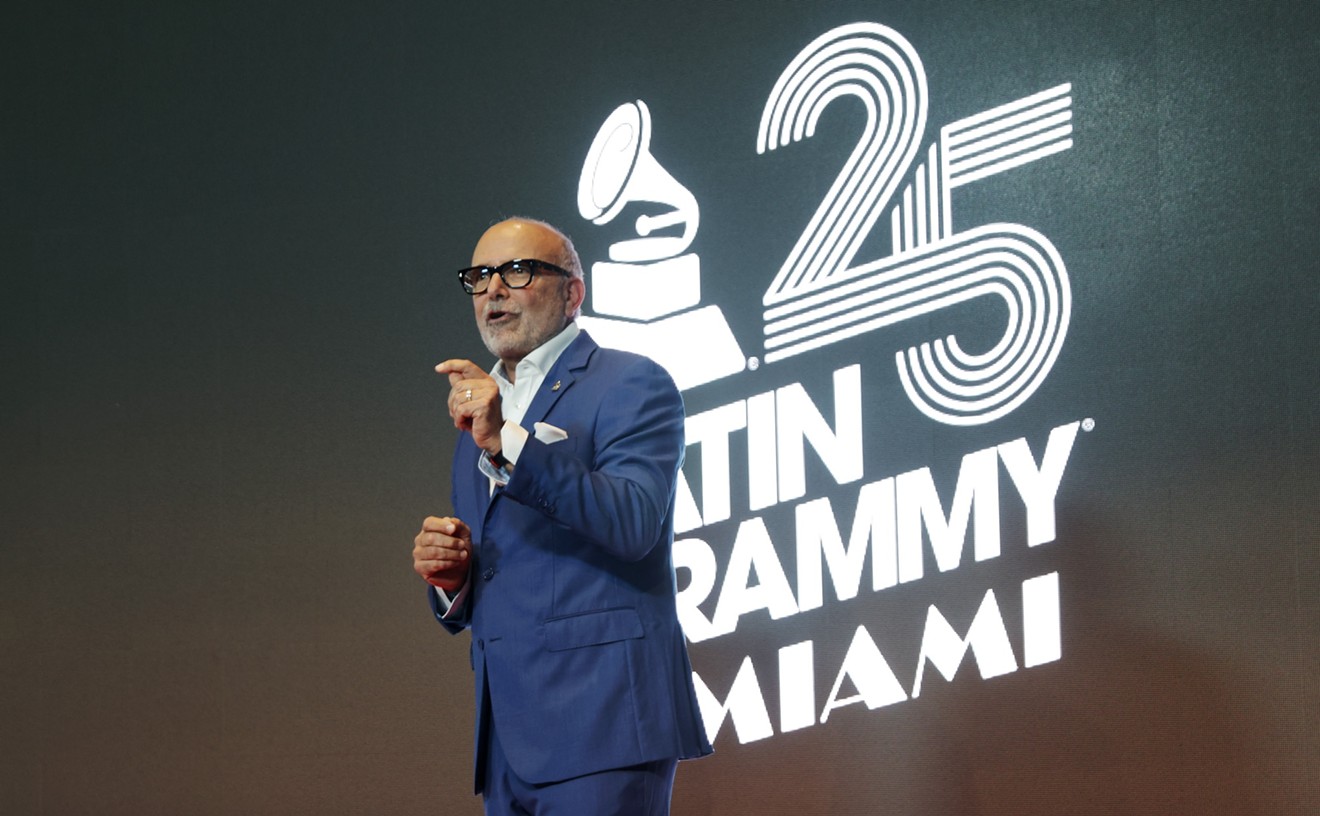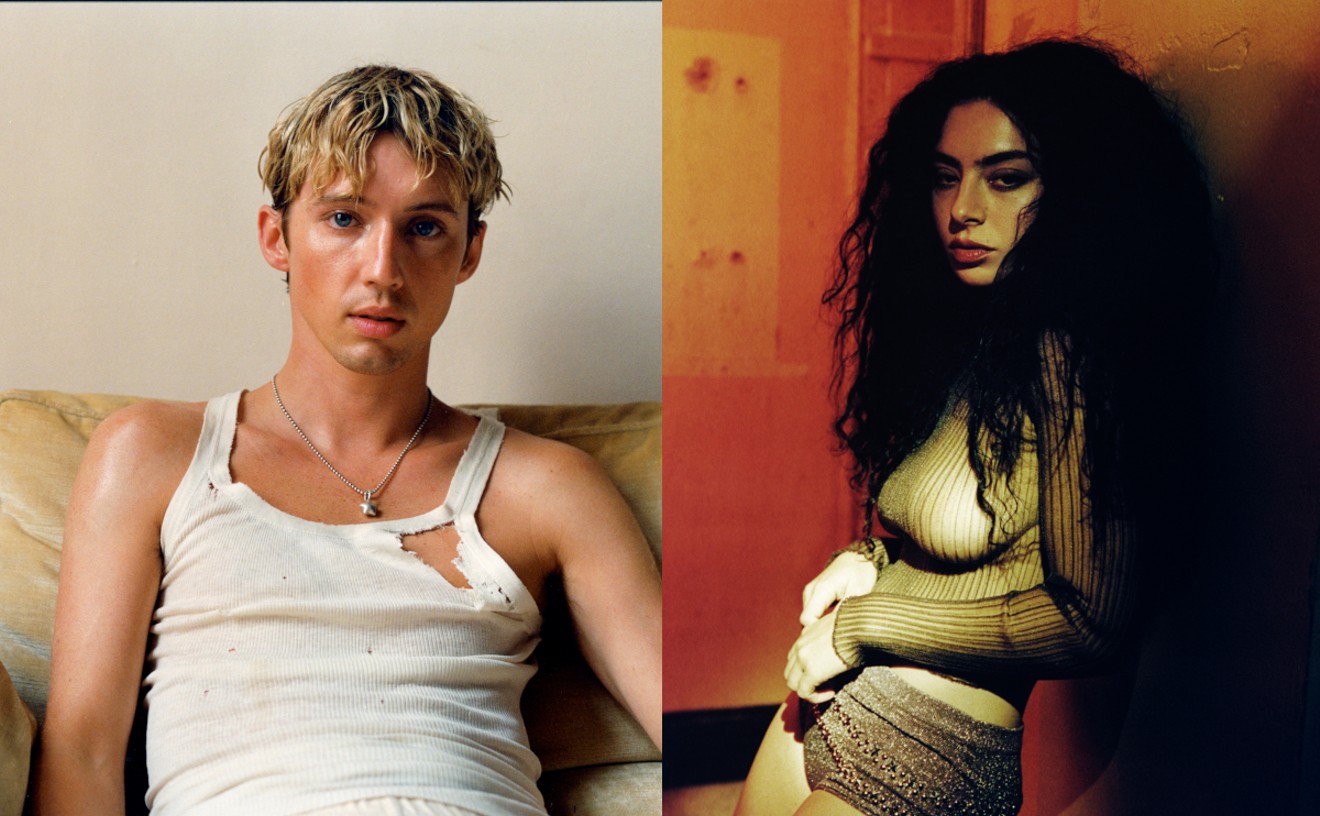Of course, that depends on who is defining "famous." At the Biltmore dozens of people do double takes and stop dead in their tracks when they see Di Blasio. Hotel workers pop out of nowhere and ask for autographs. A sextet of senior citizens from Mexico recognize him and rave about the time they saw him perform in Guadalajara. Three Costa Rican women gush and pull him aside for a photo. If that's just "well-known," when will Raul Di Blasio finally be famous? "When I get here," he explains, touching the tip of the knife.
Significantly more skilled and at ease with a baby grand than with cutlery, Di Blasio is a huge star, as much as he resists the notion and declines to act the part. He stands well under six feet tall. Today he wears jeans, a white silk polo shirt, and brown tasseled leather loafers. No socks. Perhaps it's the way his startlingly long eyelashes accentuate his coffee-color eyes, but something about his face -- a combination of youthful Sean Connery and slightly weathered Yanni -- makes it seem as if he's smiling even when he's not. His dark brown locks, loosed from their usual ponytail, recede from his forehead and graze the top of his shoulders. His bushy yet well-groomed moustache conceals his upper lip and stretches just below the corners of his mouth. Certainly not the looks of a matinee idol, but Di Blasio undeniably exudes a great deal of personal magnetism.
Already a celebrity in Latin America, he is slowly conquering the world -- one continent at a time. The latest in a long line of piano-playing entertainers such as Richard Clayderman (the French musician who has sold millions of albums through direct marketing on television) and the ostentatious Liberace, Di Blasio entrances audiences with pleasant melodies, boundless enthusiasm, and seemingly infinite energy. And he doesn't cringe at the comparison to his aforementioned brethren, although he considers himself somewhat different. "I'm a pianist -- a concert pianist doing pop music," he notes matter-of-factly.
Indeed he is. Honed from years of classical training, his style is tasteful, elegant, almost spare, often reminiscent of his heroes Chopin or Debussy. And despite humble beginnings, Di Blasio has no overwhelming desire to display the trappings of wealth by adorning his piano with a gilded candelabrum or his fingers with jewel-encrusted rings.
Born in the small town of Zapala in central Argentina, Di Blasio, the son of a farmer who owned a small market, began piano lessons at age six. "That means I've been playing just twelve years," jokes the 48-year-old musician. Until he was ten he practiced on his teacher's keyboard. When his family could finally afford to buy him a piano, it was with the tacit understanding that he wouldn't pursue a musical career. As his innate talent flourished, Di Blasio began studying the living music of Latin America -- tangos, folk rhythms, bossa nova -- as well as that of Europeans such as Beethoven, Rachmaninoff, and Liszt.
"I found everything on the piano," he points out. "It's the base, the foundation of all kinds of music. It's always been the center of my musical life." At least it was until he discovered rock and roll. As a teenager Di Blasio heard the Beatles, and like many other rebellious music-loving teens, was inspired to start his own band -- to his parents' horror. At seventeen he led the quartet Los Diabolicos (the Diabolical Ones), playing electric keyboards. The band toured and gained recognition in central Argentina but broke up in 1973.
By then Di Blasio had had enough of rock; he went back to performing classical music. For five years he traveled throughout South America playing solo dates here and there. In 1978 he landed in the Chilean resort town of Vina del Mar, where he began a lengthy stint as a hotel pianist. He grew comfortable and complacent, knowing he could stay there forever if he so desired. Five years passed before he made a decision. Di Blasio got serious -- or serious for him.
"When I was 33 I found out that I would be a pianist for the rest of my life," he declares sternly. What precipitated such an epiphany? "I flipped a coin," he says, smiling wickedly. Heads meant he would devote all of his energies to pursuing a career in music; tails meant anything else, including going back to college to study engineering, which he had attempted briefly at eighteen. Heads it was. "That's when I really decided to be a musician," he recalls. "Before that time I wasn't sure about anything."
That same year, 1983, Di Blasio acted on his decision and recorded his first album for the EMI-Chile label, followed by two more for the CBS-Chile imprint. The media in Latin America received him and his work warmly, dubbing him "El Pianista de Todos," a phrase that roughly translates to "the People's Pianist" -- apropos of someone who thinks of himself as a regular guy waging a daily battle to keep himself grounded. "What can change your personality is not you, but the people that surround you," he explains. "Sometimes they make you think you're the king of the world, and that's not true. If I'm going to change, then so is the music."
Drawn by the mixture of nationalities in South Florida, Di Blasio relocated to Miami in 1987 (he now lives in Cutler Ridge) and was subsequently signed by BMG Records. His first album for the label, El Piano de America, was released in 1990. Seventy percent of initial sales occurred in Miami, a notoriously tough market even for Latins, because of the area's cultural heterogeneity. Four albums for BMG and many tours (to far-flung places such as the Middle East and Africa) later, Di Blasio enjoyed his first million-seller in 1994 with El Piano de America 2, which featured guest vocals by Julio Iglesias and Juan Gabriel and included music that ranged from Ernesto Lecuona's classic "Malaguena" to Louis Armstrong's trademark "What a Wonderful World." (Recent albums contain a mix of Di Blasio's own compositions and songs penned by others.)
Although classical music had always been his true love, he realized he would eventually go pop: "I had a conversation with myself in the late Eighties. I looked at the market and I saw a need for a pianist like me [one who could play pop with the technique of a classical musician]. But it was all sort of intuitive because I'm not that cold and calculating. I leave that to the record people!"
The video Live! Di Blasio in Concert, recorded at the Jackie Gleason Theater of the Performing Arts in 1994, provides ample evidence of the warmth and earthiness that Di Blasio emanates on-stage. "People ask me, 'What's your formula?'" he relates. "I'm myself on the stage. I love people. I'm glad to be there, I have fun. The audience is sacred for me. They're my energy."
In support of his seventh album, 1997's Solo, Di Blasio is gearing up for a one-month tour of Asia, with stops in Hong Kong, Singapore, and Malaysia. Although he has yet to reach his ultimate goal of being completely satisfied with his work, these days he rarely gets anxious about his career. "Fame is a fantasy," he states. "What is more important for me is respect and making people happy. I want mothers, grandmothers, teenagers, all to enjoy themselves -- to cry, to be moved. Instrumental music has no barriers. It speaks the language that everybody speaks, the language of the heart."
Raul Di Blasio performs at 8:00 p.m. Saturday, April 4, at the James L. Knight Center, 400 SE 2nd Ave; 372-4634. Tickets cost $36 and $49.










